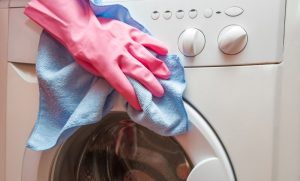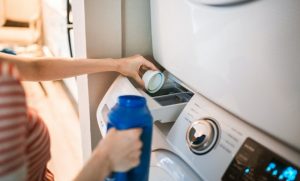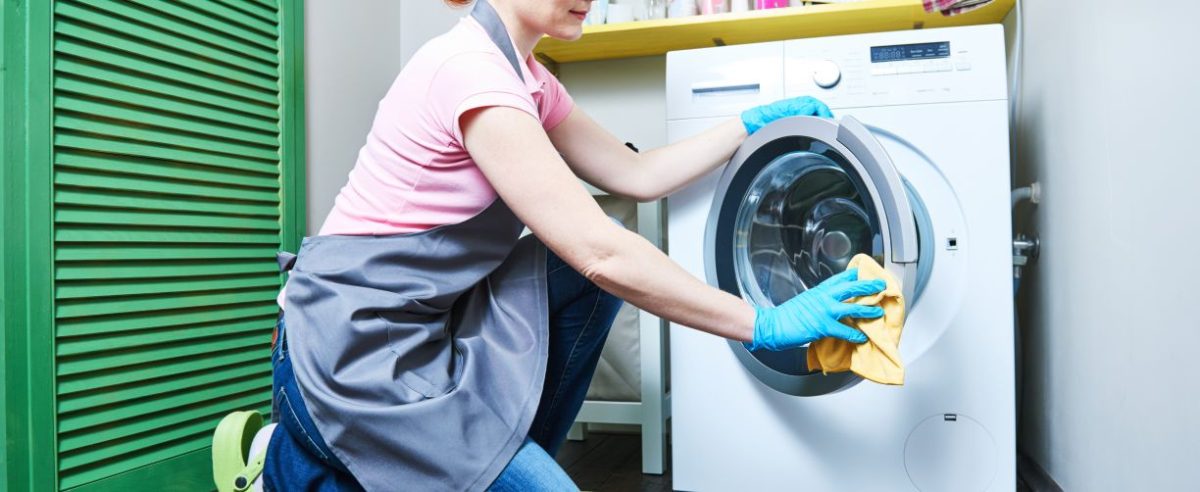The importance of washing machine maintenance
Like many new homeowners, one of the popular misconceptions that one may have when you first rent or purchase a home with a washing machine is that it doesn’t need to be maintained. This comes from the idea that a washing machine is a self-cleaning tool to be used for clothing or other cloth-made materials. After various usage of detergent and soap, the washing machine starts to obtain build-up that if left alone for a long time can be difficult to remove.
As a new homeowner, this can frustrate or bring you anxiety if you don’t know the first thing about maintaining your washing machine. Now, don’t be quick to dial your nearest home cleaning services or dry-cleaning place. There are multiple ways to clean your washing machine without having to drop dozens of dollars or sell off your washing machine for a new one.
A washing machine is an integral part of your home which means you will need to maintain it for it to function as best it can to cleanse your clothing. Having a washing machine means being responsible for its weekly, daily, or monthly operations. That is to say, you don’t need to be an expert in machinery to cleanse the inside of the washing machine and effectively upkeeping this device.
So, you may ask yourself, how to clean the washing machine? Home-cleaning remedies and tools that are commonly used to clean various parts of the house will do the trick. We will show you the most inexpensive ways to clean that only require household ingredients that you will be able to find within any home, which include:
- Bleach
- Baking soda
- White vinegar
- Nylon brush
- Toothbrush
- Dishwasher liquid
Here are some of the ways you can use to clean the holy grail of your clothes cleansing routine:
Inspection before cleansing
What do I look for before cleaning the washing machine?
Chances are if you haven’t cleaned your washing machine after some time, there are sure to be some surprises lingering beneath the surface. It is critical to inspect your washing machine before cleansing it so you will know how to tackle the problem with the right cleaning formula and tools.

For example, getting rid of a mold problem will be too difficult to get rid of with just soap and water. If the washing machine is fairly old, you could run into some rust damage which would require a different process altogether. We also suggest looking into the water supply hoses for any small cracks or tears.
If there are any damages, that would mean you would need to replacing the hoses immediately to avoid water leaks or damages in your home.
Surface cleaning
What is the best way to clean the outside of the washing machine?
The exterior is an area that although is easy to clean, can be elusive if you don’t get all the small areas that usually contain the most buildup of dirt or grime. To begin with, we suggest you remove the control knobs if they can come apart. You can wash these knobs separately in the sink for an effective cleaning strategy. Next, you will:

- Use a microfiber cloth to wipe down the surface of your washing machine, you can use an all-purpose cleaner or white vinegar for this.
- There can be lingering dirt within the space behind your washing machine or on the sides, if you can, move your washing machine just enough to clean these hidden crevices. Have a friend or relative help with moving the machine for less physical exertion on your part.
- Make sure to inspect around the washing machine for any damage to the water supply hoses or any other blemish as it can have disastrous implications if left alone.
These areas should be cleaned weekly or bi-weekly to avoid build-up or mold surfacing.
White vinegar
How to clean washing machine with vinegar?
Although there are various methods, one of the most straightforward ways to clean the washing machine is by simply using white vinegar. A miracle household product that can not only be used for cooking but also as a disinfectant, white vinegar is a natural home remedy for any gunk you wish to get rid of. Here are some steps you will need to follow to clean the inside using only white vinegar:

- Using a clean cloth and a toothbrush, you will scrub white vinegar in or around the small crevices within the machine. White vinegar is known for its antibacterial properties.
- Make sure to scrub the smaller areas, for example, the soap tray or the rubber gasket if your washing machine has one. For these areas, you can use white vinegar as well to soak your soap tray thoroughly and to rub down the rubber gasket ensuring that it’s spotless.
- If your washing machine has an area that filters the hair or debris which is located on a vertical agitator on a top-loading machine, we suggest using vinegar on this area as well.
- For the front-loading washers, you’ll need to access a small door or port that works the same in catching debris, coins, and buttons. Double-check the owner’s manual to make sure you have one.
As a powerhouse chemical, white vinegar works effectively not only to cleanse the area of all bacteria, mold, or grime but also to get rid of any foul stenches that can be leftover.
Using bleach
How to clean the washing machine with bleach
Bleach is a regular household favorite as it is used to not only clean tough stains but also acts as a disinfectant when it comes to the enhanced buildup of dirt or grime. For this process, you can use your machine to aid in the sanitation process. You will need to:

- Use the hot water setting to fill up the empty washer, choose the large load option. Hot water is a natural component when it comes to getting rid of bacteria.
- Then, you add one quart of bleach to the hot water. This will ensure that all of the muck and grime gets removed. You will then let the machine run for one minute for maximum efficiency.
- Once the minute is up, you will let the bleach and hot water sit for approximately an hour. The longer you let it sit, the easier it will be for any lingering mold or dirt spots to dissolve.
- After an hour, you will shut the door and let the machine run for one complete cycle.
- Once the cycle is done and there is no more bleach inside, you have the option of getting a more thorough cleansing if you once again fill the washing machine with hot water, but instead of adding bleach, you will add a quart of white vinegar.
- As you did with bleach, you will do the same with the white vinegar mixture and leave the top open for about an hour. Afterward, you will let the washing machine run for one cycle.
Bleach is an optimal way to deep cleanse your washing machine without spending a pretty penny or exerting your physical strength by scrubbing away at the inside. Not only will bleach remove all the mold and dirt, but it will sanitize as well as erase any harmful germs.
Sanitizing the wash drum
How to clean the washing machine drum
Chances are if you’re not familiar with the inner workings of a washing machine, or simply haven’t had experience in cleaning a washing machine then you’re unaware of the location of the washing machine drum or how to sanitize it.
The washing machine drum is where you place the detergent, softener, bleach, or other chemicals to cleanse your clothing. This compartment is part of the washing machine yet is separate and dispenses the necessary solution inside the washing machine.
This area due to consistently being filled with detergent can ultimately mean intense build-up if any spills haven’t been cleaned or simply lacks maintenance. It is important to clean this area as it is responsible for sanitizing your clothing so if there is any lingering dirt or grime it could affect the process.
To sanitize the wash drum, we recommend:
- Take a quart of white vinegar and a cup of baking soda, pour these solutions into the wash drum.
- You will then use a nylon brush or other cleaning brush to scrub the inside of the wash drum.
- Once you’re done scrubbing, you’ll put your washing machine at the hottest temperature setting.
- Then run a wash cycle so the solution can work thoroughly to remove any dirt or grime in the empty washer. Another option is the heavy-duty wash for deeper cleansing.
- To rid yourself of the vinegar smell, you can opt to run your machine once more with regular soap.
This is one of the simplest yet most effective ways to clean the wash drum in the washing machine.
Cleaning the washer lint trap
How can you clean the washer lint trap?
The washer lint trap is a compartment that helps filter loose dust, debris, or any lint attached to the clothing. For new homeowners or those who don’t have experience with cleaning their washing machine, it would be best to look at the owner’s manual to find it.
It is more than likely to be located along the top edge of the washer tub, around the center agitator, or near the end of the drainage hose. Once you find it, you will remove the compartment and soak it in hot water with liquid dishwashing soap for approximately ten minutes.
Some washer lint traps are not removable, in this case, you can use a small brush with soapy hot water to clean it manually. Once you have washed the lint trap thoroughly, we suggest also check the overall area where it was attached and cleansing it or wiping it down with white vinegar so you leave no area untouched.
Make sure to get the small crevices where it is more likely to have mold or mildew dwelling beneath.
Cleansing the water pump filter
When it comes to the water pump filter, a central part of the washing machine and how it functions, cleaning it weekly or biweekly is critical. Before beginning the cleaning process, you must have the washer empty and unplugged. Next, you will locate the water pump filter.

For many, the water pump filter is located behind an access door towards the bottom front area of the machine. If you have a top-load machine, you will need to check towards the back where there should be an outer housing to access the filter.
After locating the filter, you will then remove it and make sure there aren’t any dislodged coins, hair strands, or any other debris-like objects. For this process, you can use a small brush to help remove these materials easily.
When you have safely removed all the objects from the filter, you will then soak the filter in hot water with liquid dish soap for approximately ten minutes or so before placing it back in its compartment.
Tips for maintaining your washing machine
What are some ways you can keep your washing machine clean?
It doesn’t always have to be a painful experience to clean your washing machine every so often, there are ways you can avoid having to deep clean your washing machine so often. Here are some tips we suggest for maintaining your washing machine and avoiding some of these habits during laundry day:

- Always measure your detergent: Many who do laundry end up eyeballing the detergent and going with an amount that feels right, even though using too much detergent can lead to build-up that will, in turn, lead to mold or mildew.
- When using a front-loading machine, keep the door slightly open: this can help you also avoid mold or mildew as leaving the door closed will trap moisture inside.
- Always clean the washer lint trap once a week: This area gets the most dirt especially after washing a heavy load of clothes, keeping it clean will help your washing machine function effectively.
Ensuring that you follow these steps when cleaning your washing machine will ease your worries and avoid more costly maintenance down the line.

